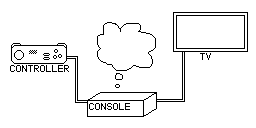Display lag
Display lag refers to the inherent latency between a console producing an output and a monitor screen displaying said output. This is different from frame delay, which is caused by the game itself intentionally delaying an input from being performed by a certain amount of time. Display lag is also separate from reaction time, which is mostly determined by the physical and cognitive ability of the player, though all three phenomena affect each other to influence the playing experience.
Display lag should not be confused with Input lag, which refers to the inherent latency between an input made on the controller and the console registering that input in the game. This is generally what causes the most delay between an input and it occurring on the screen when playing offline, assuming the right equipment is used. The average input lag is 2 frames for Smash 64 and Melee, 4 frames for Brawl, 3 frames for Smash 4 on the Wii U, and 5 frames for Ultimate. About one additional frame of display lag is added to each game to find out the total lag.
Overview[edit]
In most cases, display lag is caused by high-resolution monitors imposing additional processing on the visual data it receives on top of regular processing to analyze and produce every frame in order to make the image quality as high as possible. While this feature is useful for non-interactive applications, such as video playback and technical demos, it is often a hindrance when playing video games, as it goes against the real-time nature a majority of games require, thus resulting in a noticeable delay between input and action. Also, not all displays are created equal, with some having a significantly higher refresh rate than others, which can lead to the important minutiae of the action on-screen being lost in translation.
Display lag is difficult to quantify but easy for players to detect; controller feedbacks or inputs may be delayed, and the Wii U GamePad's screen may not be in sync with the television. It can be described as similar to playing online, though at a more constant and predictable rate.
Display lag is rarely considered a detriment with most video games, as the delay is usually so small that it is imperceivable execpt in extreme situations or if the player is actively searching for it. However, some types of games, such as rhythm games, fighting games and other games that require precise timing may become difficult or infeasible to succeed at even with small amounts of display lag. For the Super Smash Bros. series specifically, every frame of display lag decreases the possible reaction time of players, increasing the amount of prediction necessary to win and widening the size of a character's safe movepool. In particularly extreme cases combined with frame delay and sometimes Wi-Fi lag when playing online, players are able to react faster than the game itself, making reaction time completely irrelevant.
In competitive play[edit]
Display lag is an important consideration in any competition that involves a screen. In an environment where all players are supposedly at the peak of their abilities, external handicaps like display lag become increasingly more obvious and problematic. In extreme circumstances, some actions might be mathematically impossible to react to due to the screen not being able to keep up.
Owing to concerns over display lag, tournaments for Smash 64, Melee, Brawl, and Project M heavily favour setups with older, cathode ray tube televisions (more commonly known simply as CRTs) that lack significant display lag. As Smash 4 and Ultimate do not properly support 4:3 screen ratios that most CRT televisions use and need special types of cables to plug into obsolete audio and video ports, modern televisions must be used for the games' tournaments. As a result, televisions that feature a "game mode" that reduces the effects of input lag or are specifically marketed as a model intended for gaming are highly recommended at said tournaments, with other models sometimes being turned away if a tournament accepts donated setups.

